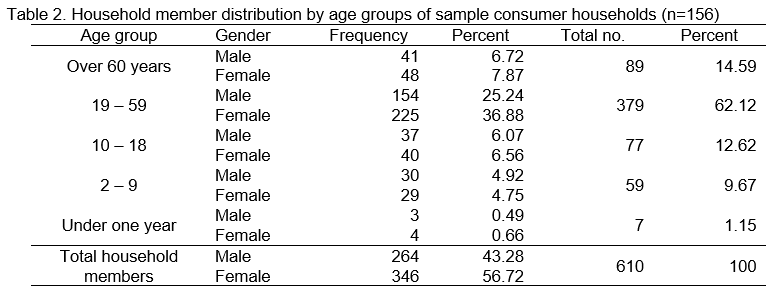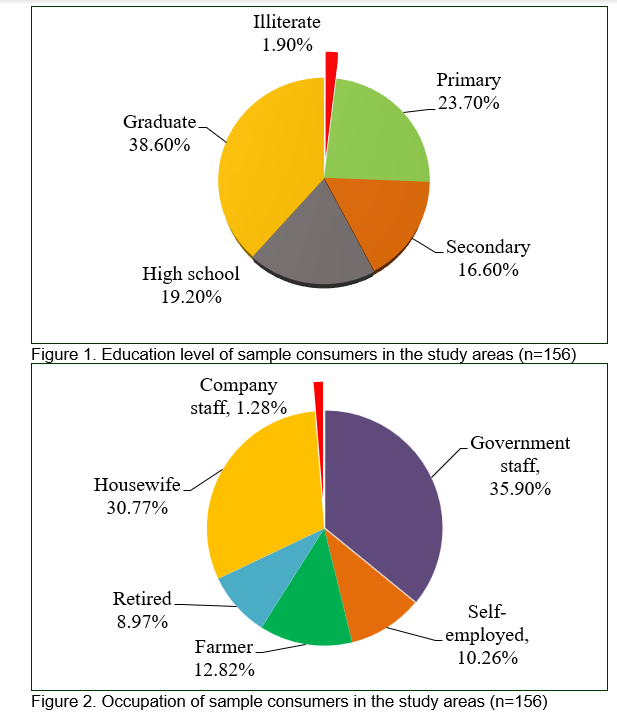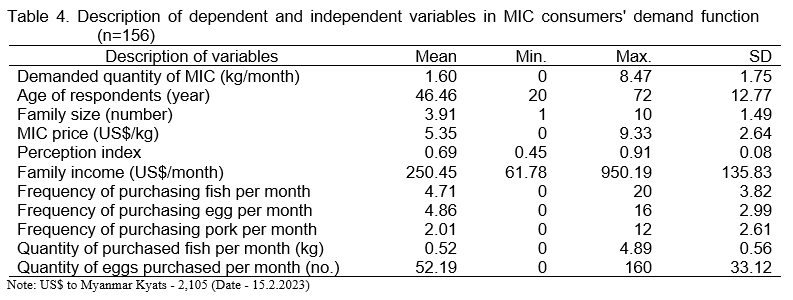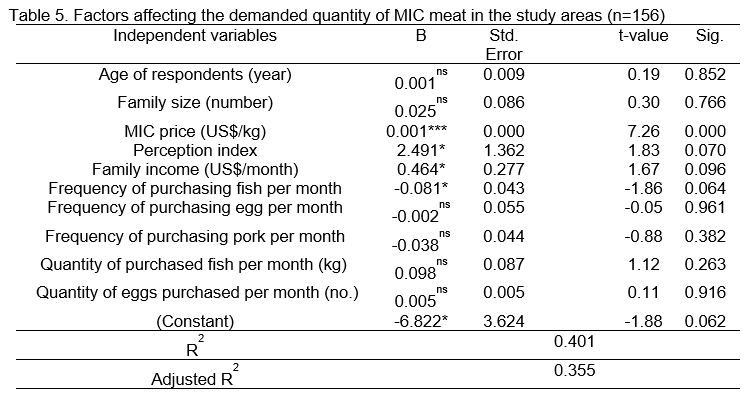ABSTRACT
Myanmar Indigenous Chicken (MIC) production plays a relatively important role in rural and peri-urban households in the country, contributing significantly to food security, income generation, job opportunity, and livelihoods of the stakeholders along with this sector. Demand for MIC meat has been growing due to population growth, changing consumer preferences, increased purchasing power, and their perception of MIC meat and meat products. This study aims to analyze per capita consumption of different meat types and eggs, and to investigate the factors affecting the determinants of different meat types and eggs, and to investigate the factors affecting the demand for MIC meat in Nay Pyi Taw. The study was conducted through a well-structured questionnaire with 156 sample consumers by using a simple random sampling method in February and March 2023 in Nay Pyi Taw. The results showed that broiler meat was the most consumed meat, followed by MIC meat and fish, which were the second most consumed meats in the study areas. The minimum consumption rate of meat types in the study areas was mutton and dried fish. The determinant factors of the demanded quantity of MIC meat were MIC own price, perception index of consumers, and family income. The own price of MIC was a highly significant factor for the demand as the relationship with household income was based on their occupation. Fish consumption had a negative effect on the demand quantity of MIC meat, showing that fish consumption becomes a competitive meat type in Nay Pyi Taw. The perception of consumers on MIC meat revealed the good potential demand for MIC meat in Nay Pyi Taw. Therefore, encouraging MIC productivity at reasonable prices is a critical issue to meet the growing demand for enhancing household nutrition, food security, and the overall livelihood of producers and consumers.
Keywords: Myanmar Indigenous Chicken, Demanded quantity, Consumer, Nay Pyi Taw
INTRODUCTION
Poultry plays a crucial role in rural livelihoods, serving as a source of animal protein and a significant contributor to household income, particularly for low-income rural and peri-urban households. Since religious beliefs in Myanmar limit beef and pork consumption, poultry meat is the most widely consumed animal-sourced food (SAPA, 2023). Poultry meat and eggs are crucial sources of protein and other essential nutrients, making them vital components of the diet in Myanmar. They are relatively affordable and widely accepted across different cultural and religious groups (Fang et al., 2021). Chicken meat and eggs provide not only high-quality protein, but also important vitamins and minerals. Chicken and eggs have become the second and third most important animal-sourced foods, respectively, after fish in Myanmar during the past decade and eggs are especially critical for the food and nutrition security of low-income households (Belton et al., 2020).
Backyard or semi-intensive poultry production systems are an important activity for many rural households. Consumption of meat and eggs from this production system is considered safe due to the habits typically observed among consumers purchasing or preparing birds from backyard poultry production. Local consumers have a higher preference for Indigenous chicken products than exotic chicken products. As a result, Indigenous chicken eggs and meat fetch a higher price than broiler chicken meat and eggs. This could be an excellent incentive to sustain the indigenous chicken species in the country (Birhanu et al., 2021).
Demand for poultry products has shown a significant increase over the past few years and is projected to continue increasing substantially in the coming decades (ICEM, 2014). The consumption and preference of Indigenous chicken meat have increased in Myanmar and are influenced by several factors, including population growth, changing consumption patterns toward a healthy lifestyle, and increased purchasing power. Accordingly, consumer preference and perception on MIC meat, consumption rate, and determinants of demanded quantity of MIC meat need to be understood and explored more to address existing demand-side information on MIC meat in Nay Pyi Taw.
Objectives of the study
To analyze per capita consumption of meat and eggs in Nay Pyi Taw, Myanmar; and investigate factors affecting the determinants of the demand for MIC meat in the study areas.
METHODOLOGY
Data collection and data analysis
In this research, primary data collection was conducted in 8 townships in Nay Pyi Taw to collect data on demographic characteristics, family income, monthly frequency, and consumption of different meat sources and eggs, MIC meat price, and perception index of consumers on MIC meat by using a structured questionnaire. Simple random sampling was used to collect data from a total of 156 consumers in February and March, 2023. Descriptive analysis and regression analysis were employed to identify the determinant factors of the demanded quantity of MIC meat in the study areas.
RESULTS AND DISCUSSION
Demographic characteristics of sample consumers in the study areas are shown in Table 1. The average age of sample consumers was 46.46 years. The oldest age of sample consumers was 72 years, and the youngest respondent was 20 years old. The average household size of the sample consumers was 3.91 and the size ranging from 1 to 10.

Household member distributions by age groups of sample consumer households were described in Table 2. The active working aged group of between 19-59 years old constituted the majority (62.12%), while household members who were over 60 years of age were 14.59%, and those less than one year of age were only 1.15%.

The education level and occupation of sample consumers were described in Figures 1 and 2. Sample consumer respondents’ education levels were divided into illiterate, primary level, secondary level, high school level, and graduate level. In these categories, illiterate referred to those who could not read and write, primary level referred to formal education up to 5 years, secondary level referred to formal schooling up to 9 years, high school level referred to formal schooling up to 11 years and graduate level referred to achievement of bachelor’s degree from university or diploma certificate from colleges. Most of the sample consumer respondents (38.60%) held a graduate level of education. About 23.70% of respondents had primary school level, 19.20% of respondents had high school level, and 16.60% of respondents had secondary school level. Only 1.90% of respondents were found illiterate.
The diverse types of occupation of the sample consumers varied, such as farmer, government staff, company staff, retired, self-employed, and housewife. According to the study results, most of the sample consumers were government staff (35.90%) and housewives (30.77%).

The annual per capita consumption of a total of 8 different protein sources by sample households in the study areas was presented in kilogram units (kg), and the number of eggs was described in Table 3. The average annual per capita consumption of broiler meat was 13.76 kg, which was the highest among all other protein source items, and ranged from 0.77 to 58.68 kg. The average number of egg consumption was 194.47, and ranged from 19.67 to 685.71 eggs.


The average annual per capita consumption of MIC meat was 8.91 kg, and it was slightly higher than beef and fish consumption of 8.64 and 8.89 kg, respectively. The average annual per capita consumption of pork, mutton, and dried fish was 6.99, 5.26, and 4.43 kg, respectively (Table 3).

Based on the results shown in Table 5, the demanded quantity of MIC meat in the study areas was positively affected by the age of respondents (year) and family size (no). It means that if the age of respondents and family size increase by 1%, the demanded quantity of MIC meat will also increase by 0.001% and 0.025%, respectively. The demanded quantity of MIC meat was also positively affected by MIC price, perception index, and family income at 1% and 10% significance levels, respectively. If the MIC price increases by 1%, the MIC meat demand will increase by 0.001%. It showed that even when the MIC price increases, consumers’ demand for MIC meat will not decrease, which is a good opportunity for the demand in the MIC market. When the perception index of consumers and family income increases by 1%, MIC demand will increase by 2.491% and 0.464%, respectively. This indicated that the higher perception index of consumers, demand for MIC meat will also be higher in the study areas. When family incomes were increased, consumers chose to buy more MIC meat in the study areas. This finding also supports the previous results, which show good opportunities for the MIC market in the study areas.
The demanded quantity of MIC meat in the study areas was negatively affected by the frequency of purchasing fish per month at a 10% significance level. If the frequency of purchasing fish per month increases by 1%, the demanded quantity of MIC meat will decrease by 0.081%. This means that consumption of fish becomes a competitive protein source for the MIC meat market in the study areas.
CONCLUSION AND SUGGESTIONS
This study investigates per capita meat and egg consumption and determinants of demand for MIC meat in Nay Pyi Taw. The findings revealed that broiler meat was the most consumed meat based on the study, and MIC meat, beef, and fish were the second most consumed meat types in Nay Pyi Taw. The study also showed that the minimum consumption rate of meat types in the study areas was mutton and dried fish.
According to the findings, the demanded quantity of MIC meat was positively and significantly affected by MIC price, perception index, and family income. This finding showed that consumers will buy and consume MIC meat even if the price of MIC meat goes up. This could be related to the high perception index of consumers on MIC meat, which is generally perceived positively in Myanmar. There are growing demands for MIC meat due to urbanization, increasing the middle-income population, changing consumer preferences, and their high perception of MIC meat in Nay Pyi Taw. It was also found that when family income increased, consumers would buy and consume more MIC meat, and this could be of good potential for MIC demand in the study areas. Therefore, implementing production and marketing strategies to improve MIC production to meet the growing demand of MIC meat. Considerations should be made for MIC meat to be nutritious, healthy, and organic, as the health consciousness and perception of MIC meat was high among demanding consumers in Nay Pyi Taw.
The quantity of MIC meat demanded in the study areas was negatively affected by the frequency of fish purchases per month. It can be concluded that fish consumption becomes competitive protein source for the MIC meat market in the study areas. Finally, special consideration should be made to encourage and create value-added products market of MIC meat in Nay Pyi Taw as this could improve livelihoods along this sector and increase overall production efficiency and profitability.
REFERENCES
Belton, B., Cho, A., Payongayong, E., Mahrt, K., and Abaidoo, E. 2020. Commercial Poultry and Pig Farming in Yangon's Peri-Urban Zone, FSP Research Paper 174. June 2020. Michigan State University, East Lansing (2020).
Birhanu, M.Y., Esatu, W., Geremew, K., Worku, S., Kebede, F.G., Unger, F. and Dessie, T. 2021. International Livestock Research Institute. Poultry production, marketing, and consumption in Myanmar: A review of literature.
Fang, P., Belton, B., Zhang, X. and Win, H.E. 2021. Impacts of COVID-19 on Myanmar’s chicken and egg sector, with implications for the sustainable development goals. Agricultural Systems 190:103094.
ICEM (International Centre for Environmental Management). 2014. USAID Mekong ARCC climate change impact and adaptation on livestock. Livestock report–Prepared for the United States Agency for International Development by ICEM. Bangkok: USAID Mekong ARCC Project.
SAPA (Sustainable and Affordable Poultry for all). 2023. Myanmar Food Security: Growing demand for affordable food and nutrition. Available online at: https://sapaproject.org/myanmar-food-security.


Per Capita Meat and Egg Consumption and Factors Affecting the Demanded Quantity of Myanmar Indigenous Chicken (MIC) Meat in Nay Pyi Taw
ABSTRACT
Myanmar Indigenous Chicken (MIC) production plays a relatively important role in rural and peri-urban households in the country, contributing significantly to food security, income generation, job opportunity, and livelihoods of the stakeholders along with this sector. Demand for MIC meat has been growing due to population growth, changing consumer preferences, increased purchasing power, and their perception of MIC meat and meat products. This study aims to analyze per capita consumption of different meat types and eggs, and to investigate the factors affecting the determinants of different meat types and eggs, and to investigate the factors affecting the demand for MIC meat in Nay Pyi Taw. The study was conducted through a well-structured questionnaire with 156 sample consumers by using a simple random sampling method in February and March 2023 in Nay Pyi Taw. The results showed that broiler meat was the most consumed meat, followed by MIC meat and fish, which were the second most consumed meats in the study areas. The minimum consumption rate of meat types in the study areas was mutton and dried fish. The determinant factors of the demanded quantity of MIC meat were MIC own price, perception index of consumers, and family income. The own price of MIC was a highly significant factor for the demand as the relationship with household income was based on their occupation. Fish consumption had a negative effect on the demand quantity of MIC meat, showing that fish consumption becomes a competitive meat type in Nay Pyi Taw. The perception of consumers on MIC meat revealed the good potential demand for MIC meat in Nay Pyi Taw. Therefore, encouraging MIC productivity at reasonable prices is a critical issue to meet the growing demand for enhancing household nutrition, food security, and the overall livelihood of producers and consumers.
Keywords: Myanmar Indigenous Chicken, Demanded quantity, Consumer, Nay Pyi Taw
INTRODUCTION
Poultry plays a crucial role in rural livelihoods, serving as a source of animal protein and a significant contributor to household income, particularly for low-income rural and peri-urban households. Since religious beliefs in Myanmar limit beef and pork consumption, poultry meat is the most widely consumed animal-sourced food (SAPA, 2023). Poultry meat and eggs are crucial sources of protein and other essential nutrients, making them vital components of the diet in Myanmar. They are relatively affordable and widely accepted across different cultural and religious groups (Fang et al., 2021). Chicken meat and eggs provide not only high-quality protein, but also important vitamins and minerals. Chicken and eggs have become the second and third most important animal-sourced foods, respectively, after fish in Myanmar during the past decade and eggs are especially critical for the food and nutrition security of low-income households (Belton et al., 2020).
Backyard or semi-intensive poultry production systems are an important activity for many rural households. Consumption of meat and eggs from this production system is considered safe due to the habits typically observed among consumers purchasing or preparing birds from backyard poultry production. Local consumers have a higher preference for Indigenous chicken products than exotic chicken products. As a result, Indigenous chicken eggs and meat fetch a higher price than broiler chicken meat and eggs. This could be an excellent incentive to sustain the indigenous chicken species in the country (Birhanu et al., 2021).
Demand for poultry products has shown a significant increase over the past few years and is projected to continue increasing substantially in the coming decades (ICEM, 2014). The consumption and preference of Indigenous chicken meat have increased in Myanmar and are influenced by several factors, including population growth, changing consumption patterns toward a healthy lifestyle, and increased purchasing power. Accordingly, consumer preference and perception on MIC meat, consumption rate, and determinants of demanded quantity of MIC meat need to be understood and explored more to address existing demand-side information on MIC meat in Nay Pyi Taw.
Objectives of the study
To analyze per capita consumption of meat and eggs in Nay Pyi Taw, Myanmar; and investigate factors affecting the determinants of the demand for MIC meat in the study areas.
METHODOLOGY
Data collection and data analysis
In this research, primary data collection was conducted in 8 townships in Nay Pyi Taw to collect data on demographic characteristics, family income, monthly frequency, and consumption of different meat sources and eggs, MIC meat price, and perception index of consumers on MIC meat by using a structured questionnaire. Simple random sampling was used to collect data from a total of 156 consumers in February and March, 2023. Descriptive analysis and regression analysis were employed to identify the determinant factors of the demanded quantity of MIC meat in the study areas.
RESULTS AND DISCUSSION
Demographic characteristics of sample consumers in the study areas are shown in Table 1. The average age of sample consumers was 46.46 years. The oldest age of sample consumers was 72 years, and the youngest respondent was 20 years old. The average household size of the sample consumers was 3.91 and the size ranging from 1 to 10.
Household member distributions by age groups of sample consumer households were described in Table 2. The active working aged group of between 19-59 years old constituted the majority (62.12%), while household members who were over 60 years of age were 14.59%, and those less than one year of age were only 1.15%.
The education level and occupation of sample consumers were described in Figures 1 and 2. Sample consumer respondents’ education levels were divided into illiterate, primary level, secondary level, high school level, and graduate level. In these categories, illiterate referred to those who could not read and write, primary level referred to formal education up to 5 years, secondary level referred to formal schooling up to 9 years, high school level referred to formal schooling up to 11 years and graduate level referred to achievement of bachelor’s degree from university or diploma certificate from colleges. Most of the sample consumer respondents (38.60%) held a graduate level of education. About 23.70% of respondents had primary school level, 19.20% of respondents had high school level, and 16.60% of respondents had secondary school level. Only 1.90% of respondents were found illiterate.
The diverse types of occupation of the sample consumers varied, such as farmer, government staff, company staff, retired, self-employed, and housewife. According to the study results, most of the sample consumers were government staff (35.90%) and housewives (30.77%).
The annual per capita consumption of a total of 8 different protein sources by sample households in the study areas was presented in kilogram units (kg), and the number of eggs was described in Table 3. The average annual per capita consumption of broiler meat was 13.76 kg, which was the highest among all other protein source items, and ranged from 0.77 to 58.68 kg. The average number of egg consumption was 194.47, and ranged from 19.67 to 685.71 eggs.
The average annual per capita consumption of MIC meat was 8.91 kg, and it was slightly higher than beef and fish consumption of 8.64 and 8.89 kg, respectively. The average annual per capita consumption of pork, mutton, and dried fish was 6.99, 5.26, and 4.43 kg, respectively (Table 3).
Based on the results shown in Table 5, the demanded quantity of MIC meat in the study areas was positively affected by the age of respondents (year) and family size (no). It means that if the age of respondents and family size increase by 1%, the demanded quantity of MIC meat will also increase by 0.001% and 0.025%, respectively. The demanded quantity of MIC meat was also positively affected by MIC price, perception index, and family income at 1% and 10% significance levels, respectively. If the MIC price increases by 1%, the MIC meat demand will increase by 0.001%. It showed that even when the MIC price increases, consumers’ demand for MIC meat will not decrease, which is a good opportunity for the demand in the MIC market. When the perception index of consumers and family income increases by 1%, MIC demand will increase by 2.491% and 0.464%, respectively. This indicated that the higher perception index of consumers, demand for MIC meat will also be higher in the study areas. When family incomes were increased, consumers chose to buy more MIC meat in the study areas. This finding also supports the previous results, which show good opportunities for the MIC market in the study areas.
The demanded quantity of MIC meat in the study areas was negatively affected by the frequency of purchasing fish per month at a 10% significance level. If the frequency of purchasing fish per month increases by 1%, the demanded quantity of MIC meat will decrease by 0.081%. This means that consumption of fish becomes a competitive protein source for the MIC meat market in the study areas.
CONCLUSION AND SUGGESTIONS
This study investigates per capita meat and egg consumption and determinants of demand for MIC meat in Nay Pyi Taw. The findings revealed that broiler meat was the most consumed meat based on the study, and MIC meat, beef, and fish were the second most consumed meat types in Nay Pyi Taw. The study also showed that the minimum consumption rate of meat types in the study areas was mutton and dried fish.
According to the findings, the demanded quantity of MIC meat was positively and significantly affected by MIC price, perception index, and family income. This finding showed that consumers will buy and consume MIC meat even if the price of MIC meat goes up. This could be related to the high perception index of consumers on MIC meat, which is generally perceived positively in Myanmar. There are growing demands for MIC meat due to urbanization, increasing the middle-income population, changing consumer preferences, and their high perception of MIC meat in Nay Pyi Taw. It was also found that when family income increased, consumers would buy and consume more MIC meat, and this could be of good potential for MIC demand in the study areas. Therefore, implementing production and marketing strategies to improve MIC production to meet the growing demand of MIC meat. Considerations should be made for MIC meat to be nutritious, healthy, and organic, as the health consciousness and perception of MIC meat was high among demanding consumers in Nay Pyi Taw.
The quantity of MIC meat demanded in the study areas was negatively affected by the frequency of fish purchases per month. It can be concluded that fish consumption becomes competitive protein source for the MIC meat market in the study areas. Finally, special consideration should be made to encourage and create value-added products market of MIC meat in Nay Pyi Taw as this could improve livelihoods along this sector and increase overall production efficiency and profitability.
REFERENCES
Belton, B., Cho, A., Payongayong, E., Mahrt, K., and Abaidoo, E. 2020. Commercial Poultry and Pig Farming in Yangon's Peri-Urban Zone, FSP Research Paper 174. June 2020. Michigan State University, East Lansing (2020).
Birhanu, M.Y., Esatu, W., Geremew, K., Worku, S., Kebede, F.G., Unger, F. and Dessie, T. 2021. International Livestock Research Institute. Poultry production, marketing, and consumption in Myanmar: A review of literature.
Fang, P., Belton, B., Zhang, X. and Win, H.E. 2021. Impacts of COVID-19 on Myanmar’s chicken and egg sector, with implications for the sustainable development goals. Agricultural Systems 190:103094.
ICEM (International Centre for Environmental Management). 2014. USAID Mekong ARCC climate change impact and adaptation on livestock. Livestock report–Prepared for the United States Agency for International Development by ICEM. Bangkok: USAID Mekong ARCC Project.
SAPA (Sustainable and Affordable Poultry for all). 2023. Myanmar Food Security: Growing demand for affordable food and nutrition. Available online at: https://sapaproject.org/myanmar-food-security.